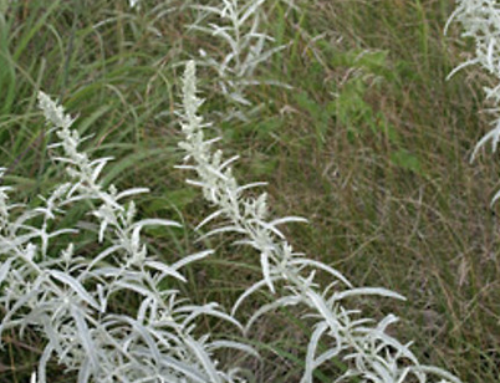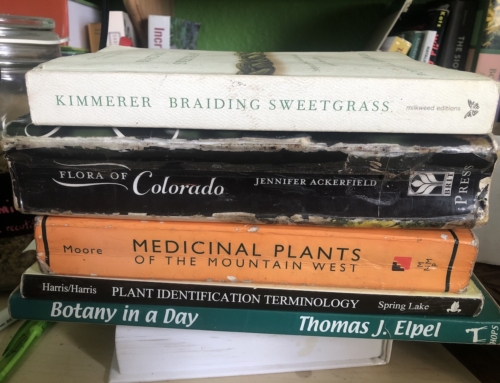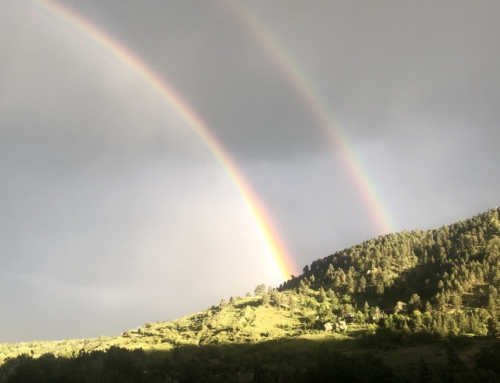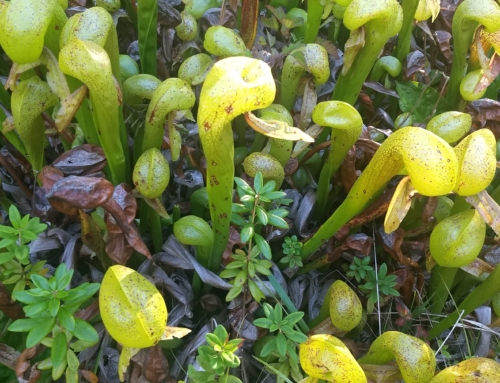Cottonwood Buds
Populus deltoides, Populus angustifolia, and their hybrid Populus x acuminata
Plant Family:
Salicaceae (Willow Family)
Related Plants:
“Populus” is a genus in the willow family (Salicaceae) that contains the different Cottonwoods (Populus deltoides and Populus angustifolia, and their hybrid Populus x acuminata), as well as Poplar (Populus alba and Populus balsamifera) and Aspen trees (Populus tremuloides).


Left: Populus deltoides, with the triangular leaf
Right: Populus angustifolia, with a narrow leaf
Appearance:
Trees are 20-40 m tall, with deep furrowed bark. P. deltoides has triangular leaves (think of the greek letter “delta”). P. angustifolia has narrow leaves (which is what “angustifolia” means – think of Echinacea angustifolia.) Populus angustifolia is sometimes mistaken for willow (Salix spp), which is in the same family, and also grows along streams and has narrow leaves. Botanically, they are differentiated by the number of scales on their buds: Willow has 1 scale and Cottonwood has 3-10 scales.
In late winter (usually late Feb-April), Cottonwood trees around Denver and throughout the foothills put out their buds covered in a protective sap that protects them from the cold, from infection, and from being eaten.

Above: Cottonwood Bud with sap
Ecology:
Cottonwoods have a strong association with water, and are common along streams and floodplains. From a mountain perch, you can see small and sometimes only seasonal streams far away by the rows of cottonwood trees visible from a distance. The elevation range is 4,200-10,500 ft, so lower-elevation Cottonwoods are available for harvest earlier (February), and higher-elevation ones are available later (May). Cottonwoods are plentiful, with no real risk of damage at this time if harvested properly (see “wildcrafting”).
Wildcrafting:
To harvest the sap-covered buds, go out after a late-winter storm and find some fallen branches. Fallen branches in late winter are extremely common, and I’ve never had to pick live buds directly off of the tree. Because the sap will melt in the spring and release the catkin (cottonwood tree flower) inside, if you get them too late in the season they may be mostly flower and very little sap, even if the whole package is still wrapped up in the bud. If I’m unsure how long a branch has been down on the ground, I check to see if the inner bark is still green (green = harvest / brown = probably not), and I taste the sap on the bud for the spicy, resinous flavor that indicates the medicinal properties. If the flavor isn’t super strong then we’ve probably had some warm weather than has melted off most of the delicious sap.
If you realize you’re arriving too late in harvesting Cottonwood, go to a higher elevation. Spring comes first in the plains, then moves up the mountains into higher elevations over time. P. deltoides tends has fatter buds to hold its larger leaves, and tends be more prevalent at lower elevations (4,200-7,500ft). P. angustifolia tends to have thinner buds and be more prevalent at higher elevations (5,000-10,500ft). And of course their hybrid is somewhere in between (4,800-8,500ft)!
Medicinal Preparations:
Pick the buds off of fallen branches and either plop then right into oil or alcohol or keep them in a bag in the freezer to prevent the sap from melting until you get around to preparing them.
Tincture:
Fill a mason jar ¾ full with buds and cover in high-percentage alcohol (75-95%). Let sit for about a month, but longer is fine.
Cottonwood Bud Oil
To make a salve, first craft your herbal-infused oil(s). Fill a mason jar ½-¾ full of buds, and cover in an oil of your choice (olive, almond, or jojoba are all good choices). Make sure your plant material is on the dry side, as water will cause oils to spoil.
Solar Method:
Place dried herbs into a dry glass jar.
Cover with olive oil.
Cap the jar tightly and place in a sunny, warm window.
If desired, the jar can be covered with a bag or box so that the oil isn’t exposed to direct sunlight.
Shake the jar once or twice per day, or as often as you remember.
If the herbs absorb the oil, then add more oil so that the herbs are always submerged.
Allow to infuse for 2 weeks.
Strain using cheesecloth or sieve.
Herbal oils will keep for about a year if stored properly in a cool, dark place.
Quick Method:
Care needs to be taken when creating herbal oils this way because you don’t want to deep-fry your herbs!
Place herbs in crock-pot or double boiler and cover with olive oil
Gently heat the herbs over very low heat (between 100 to 140 degrees Fahrenheit) for 1-5 hours until the oil takes on the color and scent of the herb.
Some herbalists recommend heating the oil 48-72 hours at a controlled temperature of 100 degrees Fahrenheit.
Turn off heat and allow to cool.
Strain, bottle, and store away from light.
Basic Salve Recipe
Ingredients
- 5 oz herbal infused oil(s) of your choice. Choose one or a combination.
- 1 oz beeswax
- 10-20 drops essential oil of choice (optional).
Directions
- Gently warm oils and beeswax over low heat until the beeswax melts.
- Remove from heat and add the essential oil.
- Quickly pour into prepared tins or glass jars and allow to cool completely.
- Salves should be stored in a cool location where they will remain semi-solid and will not continually re-melt and re-solidify. If stored correctly, salves will last for 1-3 years.
Notes
The consistency of salves can easily be adjusted depending on your preferences. Use less beeswax for a softer salve and more beeswax if you’d like a firmer salve. You can always re-melt the salve and adjust the ratio if needed.
Medicinal properties:
Cottonwood buds are used topically as an oil, salve, or liniment (a liniment is an alcohol extract used topically instead of internally). Typical uses are for sprain, strains, arthritic joints, or other pain. Its thought to work as a counter-irritant, meaning that it brings blood flow to the area. Additionally, it may be effective because most of the willow family is high in salicylic acid (an anti-inflammatory compound was researched and changed to create aspirin).
Internal use of the tincture is less common. Michael Moore uses the tincture internally as an expectorant for “thick, intractable mucus from bronchitis”, which I haven’t tried but it makes sense. I’ve been using it as a heart remedy, to help calm the nerves and move through difficult emotions. I thought I read about this use somewhere, but I can’t find a reference for it anymore, and its possible I imagined it. In my own mind, I’ve put it in the “heart exhilirant” category (meaning that it inclines the spirit toward joy), and I’m in communication with other herbalists to see if they agree with my assessment- try it for yourself and tell me what you think!
Propolis is a resin-like material made by bees from the buds of poplar and pine trees. Bees use propolis to build their hives as an anti-microbial and water-resistant layer. Someone told me that they found a rat in one of their hives that had been stung to death, then mummified in propolis to prevent it from rotting. Cottonwoods are closely related to poplar trees (same genus), and the resins of both trees are said to have antimicrobial properties. One can use the oil topically on minor skin infections or abrasions, and some people put a drop of the tincture on canker sores or cold sores. I haven’t tried this myself, but am adding it in for completeness.
Adrian Mintzmyer, CCH, CN Mountain Herbalism www.mountainherbalism.com





